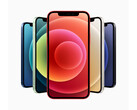Wie schnell ist das neue iPhone? Das ist natürlich immer wieder eine spannende Frage und da wir das iPhone 12 sowieso gerade im Testlabor haben, wollten wir Ihnen schon mal einen kleinen Einblick in unsere Erkenntnisse geben.
Fangen wir mal mit den Basics an und schauen, welchen Prozessor Apple diesmal in seine iPhones einbaut: Es handelt sich um den Apple A14 Bionic, der von TSMC in einem 5nm-Prozess gefertigt wird. Damit sind die Strukturen kleiner als beim A13 und Apple hat es nach eigenen Aussagen geschafft, 11,8 Milliarden Trasistoren auf dem Chip unterzubringen, das sind gut 40 % mehr als beim Vorgängerchip aus dem letzten Jahr. Auch die Neural Engine, die für KI-Aufgaben wie das intelligente Fotoalbum zuständig ist, soll deutlich ausgebaut worden sein.
Der übliche Leistungssprung der letzten Jahre bei Apple-Geräten betrug von Generation zu Generation meist zwischen 10 und 20 %. Wir haben mal einige Benchmarks herausgegriffen und vergleichen das iPhone 12 mit dem iPhone 11 und dem iPhone 11 Pro Max mit Apple A13, Samsungs Galaxy S20 und dem Asus Zenfone 7 Pro, weil dieses mit dem aktuell schnellsten Qualcomm-Prozessor ausgestattet ist.
| GFXBench | |
| on screen Car Chase Onscreen | |
| Apple iPhone 11 | |
| Asus Zenfone 7 Pro ZS671KS | |
| Apple iPhone 12 | |
| Apple iPhone 11 Pro Max | |
| Samsung Galaxy S20 | |
| 1920x1080 Car Chase Offscreen | |
| Apple iPhone 11 | |
| Apple iPhone 12 | |
| Apple iPhone 11 Pro Max | |
| Asus Zenfone 7 Pro ZS671KS | |
| Samsung Galaxy S20 | |
| 1920x1080 Aztec Ruins Normal Tier Offscreen | |
| Apple iPhone 11 | |
| Apple iPhone 12 | |
| Apple iPhone 11 Pro Max | |
| Asus Zenfone 7 Pro ZS671KS | |
| Samsung Galaxy S20 | |
| on screen Aztec Ruins Normal Tier Onscreen | |
| Apple iPhone 11 | |
| Apple iPhone 11 Pro Max | |
| Apple iPhone 12 | |
| Asus Zenfone 7 Pro ZS671KS | |
| Samsung Galaxy S20 | |
| 2560x1440 Aztec Ruins High Tier Offscreen | |
| Apple iPhone 11 | |
| Apple iPhone 12 | |
| Apple iPhone 11 Pro Max | |
| Asus Zenfone 7 Pro ZS671KS | |
| Samsung Galaxy S20 | |
| on screen Aztec Ruins High Tier Onscreen | |
| Apple iPhone 11 | |
| Apple iPhone 12 | |
| Apple iPhone 11 Pro Max | |
| Asus Zenfone 7 Pro ZS671KS | |
| Samsung Galaxy S20 | |
| GFXBench (DX / GLBenchmark) 2.7 | |
| T-Rex Onscreen | |
| Apple iPhone 11 | |
| Samsung Galaxy S20 | |
| Asus Zenfone 7 Pro ZS671KS | |
| Apple iPhone 12 | |
| Apple iPhone 11 Pro Max | |
| 1920x1080 T-Rex Offscreen | |
| Apple iPhone 11 | |
| Apple iPhone 12 | |
| Apple iPhone 11 Pro Max | |
| Asus Zenfone 7 Pro ZS671KS | |
| Samsung Galaxy S20 | |
| GFXBench 3.0 | |
| on screen Manhattan Onscreen OGL | |
| Apple iPhone 11 Pro Max | |
| Apple iPhone 11 | |
| Samsung Galaxy S20 | |
| Asus Zenfone 7 Pro ZS671KS | |
| Apple iPhone 12 | |
| 1920x1080 1080p Manhattan Offscreen | |
| Apple iPhone 11 | |
| Apple iPhone 12 | |
| Apple iPhone 11 Pro Max | |
| Asus Zenfone 7 Pro ZS671KS | |
| Samsung Galaxy S20 | |
| GFXBench 3.1 | |
| on screen Manhattan ES 3.1 Onscreen | |
| Apple iPhone 11 Pro Max | |
| Apple iPhone 11 | |
| Asus Zenfone 7 Pro ZS671KS | |
| Apple iPhone 12 | |
| Samsung Galaxy S20 | |
| 1920x1080 Manhattan ES 3.1 Offscreen | |
| Apple iPhone 11 | |
| Apple iPhone 12 | |
| Apple iPhone 11 Pro Max | |
| Asus Zenfone 7 Pro ZS671KS | |
| Samsung Galaxy S20 | |
| 3DMark | |
| Wild Life Score | |
| Apple iPhone 11 Pro Max | |
| Apple iPhone 12 | |
| Wild Life Unlimited Score | |
| Apple iPhone 11 Pro Max | |
| Apple iPhone 12 | |
| 2560x1440 Sling Shot Extreme (ES 3.1) | |
| Asus Zenfone 7 Pro ZS671KS | |
| Samsung Galaxy S20 | |
| Apple iPhone 12 | |
| Apple iPhone 11 Pro Max | |
| Apple iPhone 11 | |
| 2560x1440 Sling Shot Extreme (ES 3.1) Graphics | |
| Asus Zenfone 7 Pro ZS671KS | |
| Samsung Galaxy S20 | |
| Apple iPhone 12 | |
| Apple iPhone 11 Pro Max | |
| Apple iPhone 11 | |
| 2560x1440 Sling Shot Extreme (ES 3.1) Physics | |
| Asus Zenfone 7 Pro ZS671KS | |
| Apple iPhone 11 Pro Max | |
| Samsung Galaxy S20 | |
| Apple iPhone 12 | |
| Apple iPhone 11 | |
Sieht man sich die Ergebnisse an, so scheint die Leistungsfähigkeit des iPhone 12 tatsächlich um einige Prozent höher zu liegen als bei der Vorgängergeneration. Bei den Onscreen-Ergebnissen der Grafiktests macht sich allerdings die höhere Bildschirmauflösung gegenüber dem iPhone 11 bemerkbar, das iPhone 12 tut sich Onscreen sichtbar schwerer als sein Vorgänger, ist aber gleichzeitig flotter als das iPhone 11 Pro Max, das eine noch etwas höhere Auflösung bietet.
Vorläufiges Fazit
Der Apple A14 Bionic ist keine Wunderwaffe, die alle anderen SoCs aus dem Rennen werfen würde, aber sicherlich eines der schnellsten Systeme, die aktuell auf dem Markt verfügbar sind und damit auch noch nächstes Jahr sehr konkurrenzfähig.
Gegenüber dem Vorgänger sind die Unterschiede in den Benchmarks sichtbar, im Alltag wird es aber vermutlich nicht die reine Leistungssteigerung sein, die man spürt, sondern eher die Verbesserungen bei der KI-Engine oder bei der Bildverarbeitung für die Kamera.
Das SoC ist schneller geworden, muss sich aber im iPhone 12 bei der Grafikberechnung auf dem Display auch um deutlich mehr Pixel kümmern als noch beim Vorgänger, die Spieletests werden also interessant.












